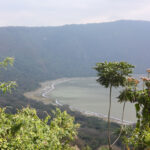
The Great Migration is one of the most spectacular natural events on Earth, and Tanzania offers some of the best vantage points to witness this breathtaking phenomenon. Here’s a comprehensive guide to experiencing the Great Migration on a safari in Tanzania:
Overview of the Great Migration
The Great Migration involves the movement of over 1.5 million wildebeest, along with hundreds of thousands of zebras and gazelles, as they travel in a circular route through the Serengeti in Tanzania and the Masai Mara in Kenya. This epic journey is driven by the search for fresh grazing and water, and it’s punctuated by dramatic river crossings and predator encounters.
Best Time to Visit
- December to March: The herds are typically found in the southern Serengeti, around the Ndutu region. This is the calving season, where over 500,000 calves are born, attracting numerous predators.
- April to June: The migration starts moving northwards through the central Serengeti, with large groups often seen in the Seronera area.
- July to October: The herds congregate in the northern Serengeti and prepare to cross the Mara River, heading towards the Masai Mara in Kenya. This period includes the dramatic river crossings, one of the most thrilling parts of the migration.
- November: The herds start moving back to the southern Serengeti, completing the cycle.
Key Safari Destinations
- Serengeti National Park:
- Southern Serengeti: Best for witnessing calving season (December to March).
- Central Serengeti: Ideal for viewing large herds and predator action (April to June).
- Northern Serengeti: Perfect for seeing river crossings at the Mara River (July to October).
- Ngorongoro Conservation Area:
- Located adjacent to the Serengeti, the Ngorongoro Crater offers year-round wildlife viewing and is a great addition to any migration safari itinerary.
- Grumeti Reserves:
- Located in the western corridor of the Serengeti, this area is known for the Grumeti River crossings (May to July).
Safari Experiences
- Guided Game Drives: The most common way to see the migration, offering the flexibility to follow the herds and observe wildlife up close.
- Hot Air Balloon Safaris: A unique and serene way to view the migration from above, providing a panoramic perspective of the vast plains and the moving herds.
- Walking Safaris: Led by experienced guides, walking safaris offer an intimate and immersive experience of the Serengeti’s flora and fauna.
Accommodation Options
- Mobile Camps: These camps move seasonally to follow the migration, ensuring guests are always close to the action. Examples include Asilia’s Olakira and Nomad Tanzania’s Serengeti Safari Camp.
- Luxury Lodges: Permanent lodges like Four Seasons Safari Lodge Serengeti and Singita Sasakwa Lodge offer luxurious accommodations and amenities.
- Tented Camps: Combining comfort and a touch of adventure, options like Lemala Ewanjan and Serengeti Under Canvas provide a classic safari experience.
Travel Tips
- Book Early: The Great Migration is a popular attraction, so booking your safari well in advance is recommended to secure the best accommodations and guides.
- Pack Wisely: Light, breathable clothing, sturdy walking shoes, a hat, sunscreen, binoculars, and a good camera are essential for a comfortable and enjoyable safari.
- Stay Flexible: Wildlife movements can be unpredictable, so a flexible itinerary allows you to adapt to where the action is.
Conclusion
A Great Migration safari in Tanzania is a once-in-a-lifetime experience that offers incredible wildlife sightings and unforgettable moments. Whether you choose to explore by vehicle, on foot, or from the air, witnessing the sheer scale and drama of the migration is sure to be a highlight of any safari adventure.





